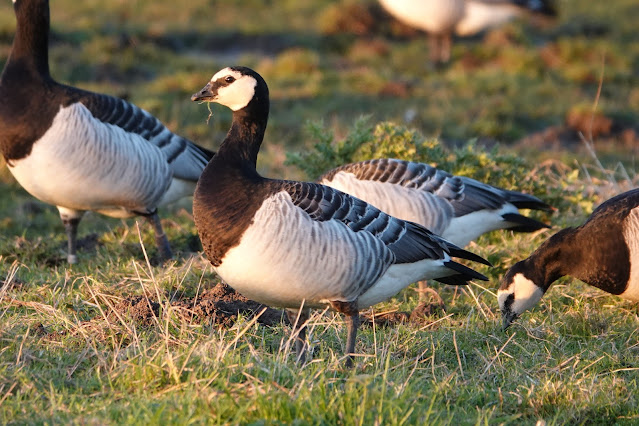Yesterday was a complete wash out. It was grim from before dawn to nearly midnight with periodically heavy lashing rain. I hid indoors and entered stuff onto iRecord and reminisced about summer insects.
Today was glorious but I had to sit in and wait for the gas
man to come service our 50 year old back boiler and after it was given the all
clear at midday I headed down to Southwold to meet up with the Whitfields for
an amble around the town marsh.
Following the exploration by Antony and myself last Thursday
I worked out that a full circuit could be done which would take in more of the
flooded meadows. We parked up near the water tower and walked down York Road. The meant that the light was good looking
east over the fields and before too long I had located the Lesser Yellowlegs as
it fed with its scattered Redshank relatives.
 |
| Essence of Lesser Yellowlegs |
It was now largely grey and white with a hint of some wing
markings and quite a pronounced supercilium while the legs were vivid
yellow. Margaret suggested custard but
we had to qualify that with it not being M&S Finest Madagascan Vanilla kind
of yellow but more a vivid cheaper Bird’s version…
A single Golden Plover was with the Lapwing and both species
gleamed in the low winter sunshine while just a couple of Curlews dotted
amongst them this time. A Cetti’s
Warbler called from the reedy ditch but there were no errant Wagtails around
the pool margins. The Carlton Marshes
Eastern Yellow Wagtail returned two days after our calling bird here and Bradders
had another at Benacre briefly on Saturday.
I just wish we had actually seen it!
Turnstones were mumping crumbs from a chap on a bench down
at the river mouth and off shore may have looked calm but the swell was huge
and amongst those waves were at least 120 Scoter actively feeding but the light
was tricky and I could not find any Velvets.
A single female Eider and three Mergansers headed south along with three
Pinkfeet with two Cormorants!
 |
| Turnstones and buddy |
The walk back on the inside path gave excellent views of the
Barnacle Goose flock and we read loads of rings amongst them. Those two small Greylags were again present
although not immediately obvious and it was clear that the bills were also
pinker rather than fully orange, especially towards the end where the pale nail
was quite obvious. I have put something
out on Twitter so see if anyone else has any thoughts about whether they could
be of more northerly origin but they are Greylags and I suspect the post will
be glossed over.
The Barnacles were spectacular and although close were
suitably cautious of us standing there watching them. The white glowed golden and the black and
dove grey gleamed. There is something
very special about a flock of wild Geese and these naturalised Barnies are no
exception. I will post further once I
hear back on some of their origins.






.JPG)
.JPG)
.JPG)











No comments:
Post a Comment